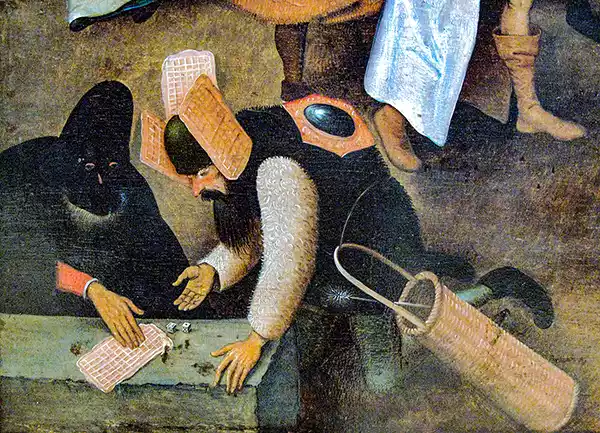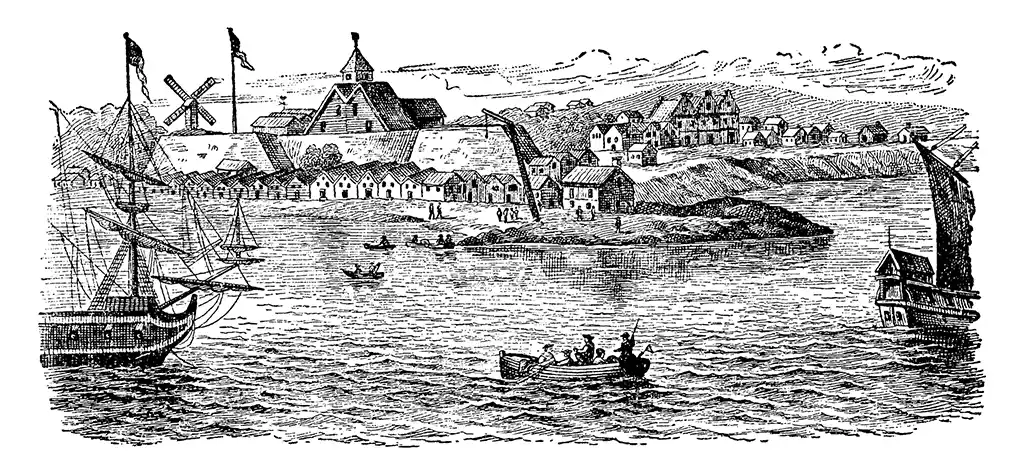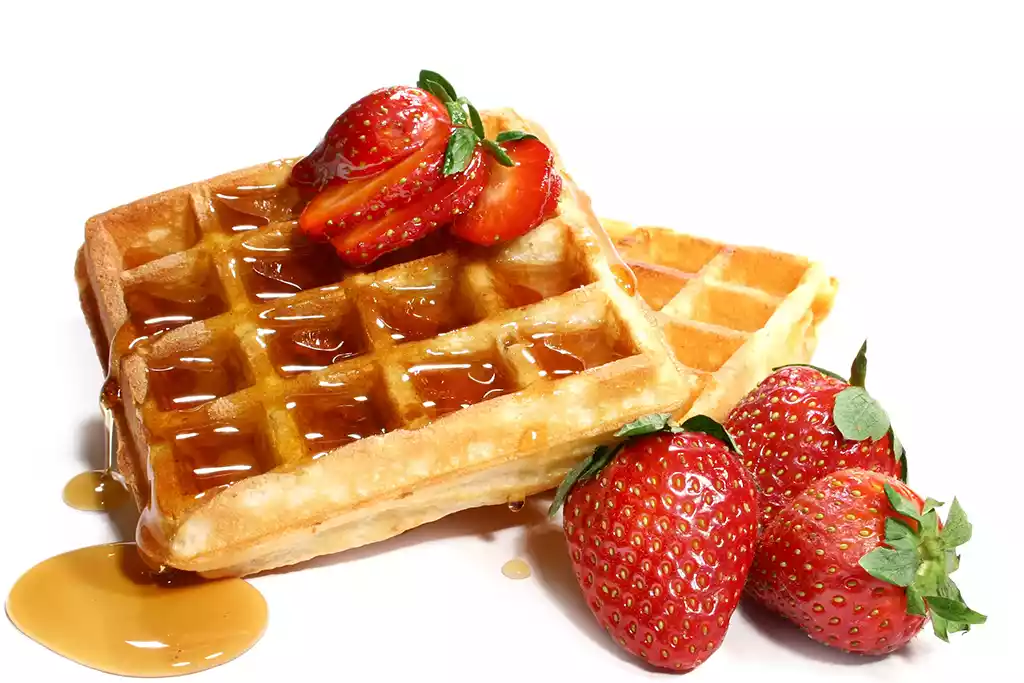Author: Tosh Lubek Published: 5th April 2022
KitchenAcorns.com is supported by its readers. Please assume links on this site are affiliate links or ads, and that I get commissions for purchases made through these links. As an Amazon Associate, I earn from qualifying purchases. Thank you if you use any of the links.
It is difficult to pin the invention of the waffle on any one person, mostly because the roots of the modern-day waffle are deep.
The first known waffle recipe appeared in 1393 in Le Ménagier de Paris, but the author is unknown. The recipe includes eggs, salt, wine, and flour, but no leavening agent. It is possible that yeast, either in the wine or naturally occurring in the air, leavened the dough.
The idea that these waffles were yeast-leavened is not unreasonable. Medieval wine could have contained both live yeast and unfermented sugar and be used in the same way that some early bakers used the yeast in beer to make their bread rise. In those times women frequently made beer in the home, because for many, beer was the only safe thing to drink. So, it is likely that yeast was present on surfaces, cooking utensils, and in the air.
Early bakers also took advantage of airborne yeast to leaven their bread. The dough would be left uncovered, and yeast in the air would settle on the dough, resulting in fermentation that would make the bread dough rise.
So, although yeast is not mentioned as an ingredient in the waffle recipe of Le Ménagier de Paris, it seems inevitable that it would have naturally been present in the kitchen.
However, it wasn’t until the 15th century that the cooking irons were made rectangular and started to include a shallow grid pattern. The recognizable rectangular form with a grid of deeper square pockets seems to have been established in the Low Countries by the 16th century.

We can see waffles made in such irons depicted in a print from 1558 by Frans Hogenberg and more clearly shown in Pieter Bruegel’s The Fight Between Carnival and Lent from 1559. In this painting, the waffles are larger than modern 4”x7” Brussels waffles.
Conveniently, a dice player is shown with his hand on a waffle, allowing us to estimate its size to be about 6”x10”, with a 7×12 grid pattern.
By the middle of the 16th century not only had the familiar waffle shape appeared, but so had recipes with additional ingredients that we might use, like white flour, sugar, melted butter, cream, milk, spices, and yeast. But ingredients like white flour and especially sugar would only be available to the nobility and wealthy families. So, most would have eaten waffles that were made from more common whole grains that were either unsweetened or possibly sweetened with honey.
Over the next two centuries, the waffle became widespread across Europe, and especially popular in the Netherlands, Belgian, Germany, and France. As the cost of sugar fell, due to the rise of Caribbean sugar plantations, sweet waffles became more widely available. At the same time, waffle recipes became more diverse and indulgent, with some recipes including ingredients such as whipped eggs, citrus zest, and grated chocolate used in the waffle batter. We know there were many regional waffle recipes, and to an extent, that is true to this day.
By 1725 we can be certain that the English word “waffle” was being used since it appeared that year in Robert Smith’s Court Cookery. Thereafter, waffle recipes became widely known in both England and America.

English settlers may have taken waffle recipes with them to their American colonies, but the Dutch certainly introduced waffles to their settlement on the southern tip of Manhattan Island, which would later be renamed New York by the English.
For the first half of the 19th-century waffles remained popular in Europe. There are records of Florian Dacher selling thick Brussels Waffles from his shop in Ghent, Belgium around the 1840s. About thirty years later his friend and cook, Philippe Cauderlier, published the first recipe for Brussels waffles in his cookbook, La Pâtisserie et Les Confitures. The Brussels waffle, or a derivation of it, is what we think of as a Belgian waffle.
The Liège waffle, the other iconic Belgian waffle, is claimed to originate in the 18th century, but waffle recipes that had crushed block sugar added to the dough are not mentioned until the 19th century. Even so, the earliest recipe for Liège waffles dates from 1921. Whatever the truth, they’re truly delicious for anyone with a sweet tooth.
In the first half of the 20th-century waffles had become a predominantly homemade food in America. Commercial electric waffle makers started to appear, along with readymade dry waffle mixes cementing the American waffle as a breakfast favorite. By the middle of the 20th century, frozen waffles started to appear, making it even easier to quickly serve waffles at home.
The American Belgian waffle began its rise to popularity in the 1960s when Belgian-style waffles were
The American Belgian waffle began its rise to popularity in the 1960s when Belgian-style waffles were offered to the American public at the 1962 Seattle World’s Fair, and then the 1964 New York World’s Fair. The American Belgian waffle was the result of merging attributes of the existing American waffle with those of the Brussels waffle. The extra thickness and larger pockets of the Brussels waffle stayed in, but the whipped egg whites and/or yeast for leavening were replaced with baking soda, as used in American waffle mixes. The American Belgian waffle was born.
So, we can’t say that anyone person invented the waffle, as we now know them in America and the UK. Instead, modern waffles are the result of the introduction and evolution of cooking technology coupled with existing recipes, the availability of newly affordable ingredients, and the actions of many entrepreneurs who saw an opportunity to make money.

However, that’s not really the end of the waffle story. It continues to evolve. For instance, there’s the emergence of the Hong Kong Bubble Egg Waffle that can be folded over to form a sandwich or rolled into a cone ready for scoops of ice cream.
Then there’s the KC Waffle Dog from Hawaii that’s a hotdog surrounded by waffle batter.
To make eating waffles easy while on the go, how about a Waffle-on-a-Stick, which is exactly as it sounds, but you might want it dipped in chocolate and covered in candy sprinkles or chopped nuts.
Whichever type of waffle you prefer – Enjoy!
Need a new waffle maker? See the excellent choice on Amazon
Tosh learned how to cook while watching his Polish Mom at home. He also worked in a family-owned restaurant while a student and learned much from the chefs. Cooking has always interested him, especially the hearty Polish recipes he learned from his mother. He has helped create and appeared on cookery shows on radio stations in Scotland.
Recent Posts
This family pancake recipe will make about thirty-six pancakes that have a thickness of about 3/8th to half an inch and a diameter of about 4 inches. In my family, I would often prepare a batch of...
If you want to know a lot more about waffles but don’t have the time to read through loads of articles, you’re in the right place. I’ve collected together 25 of the most often asked...







